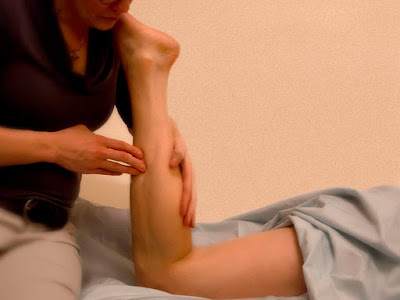What is myofascial pain and how is it diagnosed? These questions will be answered here...
No it was not Trigeminal Neuralgia it was Sternocleidomastoid (SCM) of which I had never heard.
Anyway it convinced me to go to get myofascial treatment which I had heard can help fibro.
Myofascial treatment is a specific type of massage that releases the myofascial tissues. Myo means muscle and fascia means the connective tissue covering the muscles. These connective tissues become tight and painful and need to be released.
Myofascial pain is usually caused in specific tender points that need to be released. It is a constant, deep pain that I would describe as a tender muscle that is held tight. It makes me feel like my legs cannot relax and that I have clenched my muscles so much that they will not let go. I have learnt that it is in a part of my body that I had never heard of... the fascia. Also I learnt that there is a layer of fascia just under the skin and another layer deep in the muscles.
Fascia is a thin casing of connective tissue that surrounds and holds every organ, blood vessel, bone, nerve fiber and muscle in place. The tissue does more than provide internal structure; fascia has nerves that make it almost as sensitive as skin. When stressed, it tightens up. ~ JOHN HOPKINS MEDICINE
My first Myofascial Massage
Honestly—it felt like my body exhaled for the first time in weeks.
It wasn’t the kind of massage that pushes through pain or forces release. It was slow, intentional, almost like the therapist was listening to my muscles with their hands. They found the taut bands and applied just enough pressure to coax them into softening.
At first, there was a kind of ache—deep and familiar, like the pain had been waiting to be acknowledged. But then something shifted. The pressure met the resistance, and instead of bracing against it, my body started to trust. I could feel the tension unraveling, like threads loosening in a tightly wound knot.
Afterward, I felt lighter—not cured, but clearer. My muscles weren’t shouting anymore. They were whispering. I could move without flinching. I could rest without feeling clenched.
 |
| Myofascial technique in the lower leg. Image thanks to StillpointTherapeutic Massage & Bodywork. |
There is a book explaining the condition called Fibromyalgia and Chronic Myofascial Pain Syndrome: A Survival Manual which you read my review of hereHow is myofascial pain diagnosed?
The recognition of this syndrome requires a precise understanding of the body's trigger points. Trigger points can be identified by pain that results when pressure is applied to an area of the patient's body. In the diagnosis of myofascial pain syndrome, four types of trigger points can be distinguished:
- An active trigger point is an area of extreme tenderness that usually lies within the skeletal muscle and which is associated with a local or regional pain.
- A latent trigger point is a dormant (inactive) area that has the potential to act like a trigger point.
- A secondary trigger point is a highly irritable spot in a muscle that can become active due to a trigger point and muscular overload in another muscle.
- A satellite myofascial point is a highly irritable spot in a muscle that becomes inactive because the muscle is in the region of another trigger pain. FROM CLEVELAND CLINIC

This is fascinating and gives me some hope, I will investigate about it Gracia
ReplyDeleteYou are most welcome. It gives me hope too Sophia because sme of the muscle pain experienced in fibromyalgia can be treated.
DeleteMany doctors actually use this diagnoses to treat so that insurance companies will pay for the treatments. This often includes massage therapy, which I couldn't operate without.
ReplyDeleteYes, healthy mom, massage therapy really helps me cope with fibro pain too. Glad it helps you and you can get some reimbursement through your health insurance.
DeleteI do trust all the concepts you have presented for your post.
ReplyDeleteThey're very convincing and can definitely work. Still, the posts are very short for newbies. May just you please lengthen them a bit from subsequent time? Thank you for the post.
Also visit my site ... muscle supplememts
Do you folks have a facebook fan page? I LOOKED for one on twitter but couldn't discover one, I would really like to turn into a fan!
ReplyDeleteHi Scmidt, yes we do have a facebook page and thanks for asking. There is a small blue icon in the right hand sidebar that takes you to it or just go to https://www.facebook.com/FibroFiles/
Delete